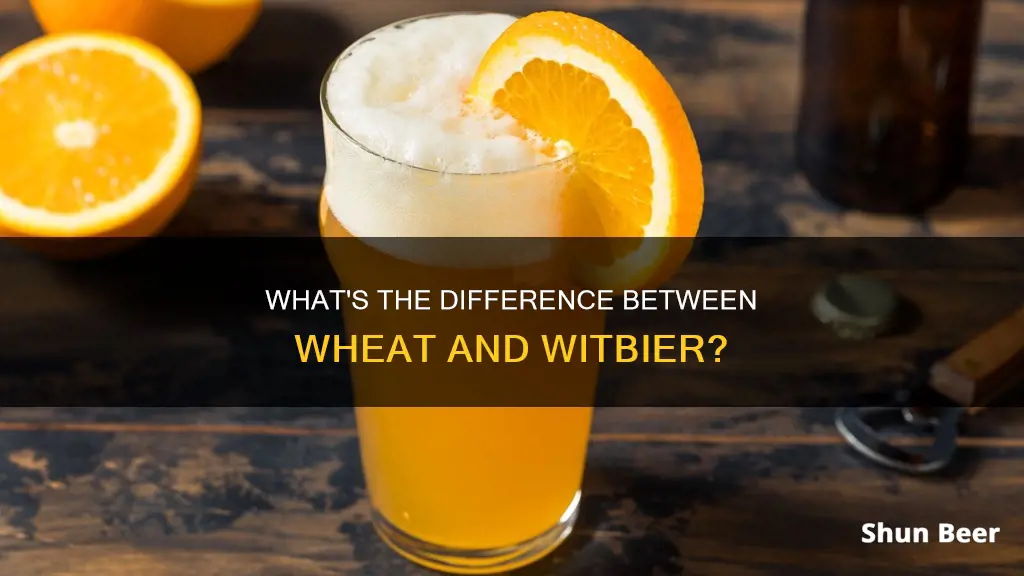
Wheat beer is a category of beer that typically uses a higher proportion of wheat in the brewing process compared to the amount of malted barley. The two main varieties are German Weizenbier and Belgian Witbier, with the former being the most widely known type of wheat beer. Wheat beers are usually light in colour, low to medium in alcohol content, and can be cloudy or clear. They are often brewed with hops and tend to lack bitterness. Witbier, meaning white beer in Dutch/Flemish, is made using unmalted wheat and is spiced with coriander and orange peel, giving it subtle spicy notes.
| Characteristics | Values |
|---|---|
| Name | Wheat Beer, Witbier, Weizenbier, Weisse, Weizen, White Beer, Bière Blanche |
| Origin | Belgium, Germany |
| Main Ingredients | Wheat, Barley, Hops |
| Other Ingredients | Unmalted Wheat, Spices, Coriander, Orange Peel, Oats, Yeast |
| Appearance | Cloudy, White, Hazy |
| Taste | Fruity, Spicy, Citrusy, Sour, Sweet, Tangy, Creamy, Crisp |
| Alcohol Content | 2.5% to 10% ABV |
What You'll Learn
- Wheat beer is a category of beer originating in Bavaria
- It is typically top-fermented ale
- Wheat beers are usually light in colour, low to medium in alcohol content, and can be cloudy or clear
- Witbier is a variety of beer brewed using unmalted wheat and spiced with coriander and orange peel
- Berliner Weisse is a wheat beer that is low in alcohol content and intentionally tart

Wheat beer is a category of beer originating in Bavaria
The two main varieties of wheat beer are German Weizenbier and Belgian Witbier. Weizenbier, or Hefeweizen as it is known in southern Bavaria, is a traditional Bavarian wheat beer that was introduced to the region from neighbouring Bohemia in the 15th century. By law, Weizenbiers brewed in Germany must use a top-fermenting yeast, which produces overtones of banana and clove. The beer is also characterised by its low hop bitterness and relatively high carbonation.
Witbier, on the other hand, is a Belgian-style wheat ale that originated in the Flemish region of Belgium during the Middle Ages. It is typically brewed with raw unmalted wheat, as well as spices such as coriander and orange peel, giving it a unique flavour profile. Belgian Witbiers are also known for their cloudy, white appearance due to the suspended yeast and wheat proteins.
Other types of wheat beer include Lambic, made with wild yeast; Berliner Weisse, a cloudy, sour beer; and Gose, a sour and salty beer. Wheat beers can also vary in name depending on the region they are brewed in, with different names used in Southern Germany, Western and Northern Germany, and Switzerland.
Wheat beers are known for their flavour characteristics, which set them apart from other types of beer. They tend to have tropical fruit, banana, and citrus flavours, and are usually light in colour with a nice head due to carbonation. Wheat beers also vary in alcohol content, typically ranging from 2.5% to 5% ABV but sometimes reaching as high as 8-10% ABV for stronger "grand cru" versions.
Wheat Beer: Healthy Choice or Just Hype?
You may want to see also

It is typically top-fermented ale
Wheat beer is typically a top-fermented ale. Top fermentation is a mode of fermentation in which the yeast rises to the surface of the wort, allowing it to be "skimmed" from the vessel. Top-fermenting yeast, also known as ale yeast or Saccharomyces cerevisiae, is hydrophobic and tends to seek the surface of the liquid to escape the aqueous milieu of the fermenter contents. Top fermentation is traditionally carried out in open, stainless steel fermenters that are either square or round in cross-section and typically 2–4 metres deep.
Top fermentation tends to be a faster method, usually requiring a minimum of a week or more to fully ferment. The yeast needs to be kept at higher temperatures of around 60 to 75 degrees Fahrenheit (16 to 24 degrees Celsius). Top-fermented beers often have complex or full-flavoured profiles, with spicy and fruity tones. They are also known for their generous stand of foam, especially with the high protein content of wheat malt.
The two main varieties of wheat beer are German Weizenbier and Belgian witbier. Weizenbier, also known as Weißbier, is a light-coloured beer that uses at least 52% wheat to barley malt. Witbier, meaning "white beer" in Dutch, is brewed with flavourings such as coriander and orange peel, and is often hazy or cloudy due to the presence of suspended yeast and wheat proteins.
Other styles of wheat beer include Lambic, made with wild yeast; Berliner Weisse, a cloudy, sour beer; and Gose, a sour and salty beer. Wheat beers can vary in appearance, ranging from clear to cloudy, and tend to be light in colour, with low to medium alcohol content. They may be brewed with or without hops and typically lack bitterness, making them easy to drink.
While wheat beer is typically top-fermented, it is important to note that there may be some variations or exceptions within the different styles and brewing techniques employed by brewers worldwide.
Is Pacifico Beer Wheat-Based?
You may want to see also

Wheat beers are usually light in colour, low to medium in alcohol content, and can be cloudy or clear
Wheat beers are typically light in colour, ranging from pale yellow to gold. Some varieties, such as Dunkelweizen, are darker in colour, with a sweet maltiness. Wheat beers are often low to medium in alcohol content, typically ranging from 2.5% to 5.4% ABV. The alcohol content can vary depending on the style, with some stronger varieties having up to 10% ABV.
Wheat beers can be cloudy or clear in appearance. The cloudiness comes from the presence of yeast and wheat proteins, which can also give the beer a hazy or white appearance when served in a glass. The clarity of wheat beer can depend on the style and brewing process, with some varieties being intentionally cloudy, while others are filtered to remove the yeast and proteins, resulting in a clear appearance.
Wheat beers are known for their light and refreshing flavour profile, with minimal bitterness and a low to moderate level of alcohol. They often have a subtle fruity or spicy character, with notes of banana, clove, or coriander. The use of wheat in the brewing process gives wheat beers a creamy texture and a hint of tanginess, making them perfect for summer drinking.
The appearance and flavour of wheat beer can vary depending on the style and brewing techniques used. While some wheat beers are cloudy and hazy, others are clear and golden. The alcohol content can also range from low to medium, depending on the specific variety and brewing techniques. Overall, wheat beers offer a refreshing and easy-drinking experience, making them popular among beer enthusiasts.
Wheat Beer: What Sets It Apart?
You may want to see also

Witbier is a variety of beer brewed using unmalted wheat and spiced with coriander and orange peel
Wheat beers are predominantly made using wheat and a touch of barley. They can range from pale to dark and offer a variety of flavours, including fruity and spicy notes. Witbier, also known as bière blanche in French, is a variety of wheat beer.
The name witbier means "white beer" in Dutch and refers to the cloudy, white appearance of the beer when poured into a glass. This is due to the use of unmalted wheat, which hasn't had its starches converted to fermentable sugar, resulting in a lighter body and mouthfeel than other wheat beers. Witbiers are typically brewed with coriander and citrus or other spices, complementing the bready, bright wheat notes. The spices should be subtle, leaving drinkers wondering about the ingredients.
Witbiers originated in Belgium as early as the 14th century and were once the everyday drink of the region. By the 1950s, however, the last witbier brewery in Hoegaarden, Belgium, had closed its doors. The style was later revived by Pierre Celis, who started the Hoegaarden brand. Witbiers are typically cloudy, with a creamy texture and a fruity and spicy flavour profile. They are often served in a short, round-rimmed tumbler glass.
While witbiers are Belgian in origin, there are now many American interpretations of this style, such as Blue Moon Belgian White, which offers hints of orange peel and coriander.
Wheat Beer Allergies: Understanding the Connection and Symptoms
You may want to see also

Berliner Weisse is a wheat beer that is low in alcohol content and intentionally tart
Berliner Weisse is a style of wheat beer that originated in the region around Berlin, Germany, dating back to at least the 16th century. It is a cloudy, sour beer with an alcohol content of around 3-5% ABV, typically falling in the range of 3-3.5%. It is intentionally tart, with a distinctive lactic acid taste created by the use of lactic acid bacteria during fermentation. This beer style is known for its low bitterness, high carbonation, and refreshing quality.
Berliner Weisse is brewed with a combination of malted barley and wheat, with the malts being kilned at very low temperatures or air-dried to minimise colour formation. The wheat component, typically around 50% in the grain bill, contributes to the beer's characteristic cloudiness and body. The use of Lactobacillus, a naturally occurring bacteria, gives Berliner Weisse its signature acidity and tartness.
The traditional way to drink Berliner Weisse is to add flavoured syrups such as raspberry (Himbeersirup) or artificial woodruff flavouring (Waldmeistersirup). It is often served in a bowl-shaped glass, and the beer's sourness can also be balanced by mixing it with other drinks, such as pale lager.
Berliner Weisse was incredibly popular in the early 19th century, with over 700 German breweries producing it. However, by the late 20th century, only a handful of breweries in Germany were still producing this style of beer. In recent years, it has gained popularity again, especially in the United States, where American brewers have added their own twists to the traditional German style.
The complexity and unique characteristics of Berliner Weisse make it a fascinating and enjoyable beer style, offering a harmony of yeast and lactic acid that creates a refreshing and satisfying drinking experience.
Landshark Beer: Is It Safe for Wheat Allergies?
You may want to see also
Frequently asked questions
Wheat beer is a style of beer that’s made predominantly using wheat (with a touch of barley). The use of wheat gives a uniquely light and refreshing profile to the beer, although there are various different types, each with different attributes. Wheat beers can range from pale to dark, and they offer a diverse range of flavours, including fruity and spicy notes.
The most common styles of wheat beer are Hefeweizen, Weissbier, American wheat ale, Belgian Witbier, and French Bière Blanche.
Simply put, Witbier is Belgian and Weissbier is German. Witbier uses unmalted wheat, while Weissbier uses 50% wheat malt. Witbier also contains less wheat than Weissbier, which influences the overall taste profile.
Witbiers taste fruity, with a pleasantly earthy finish. They are typically brewed with coriander and citrus or other spices, which act as complementary flavours to the bready, bright wheat notes.
Weissbiers are known for their characteristic clove and banana flavours, which come from the special weizen yeast used in brewing.







